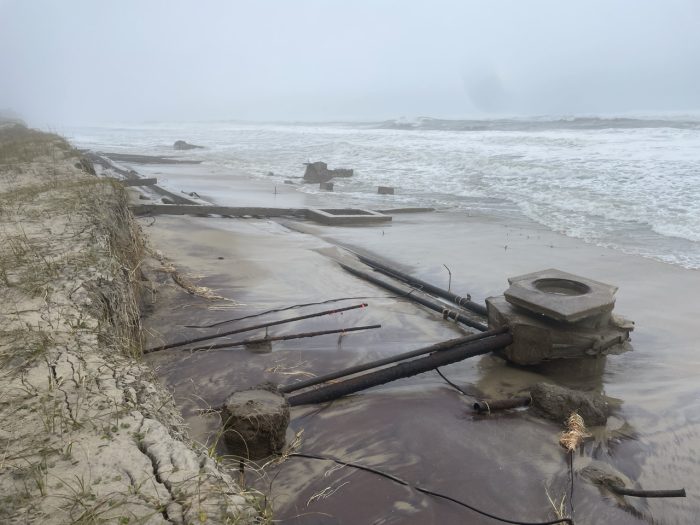
On Sunday, March 24, the Cape Hatteras National Seashore sent out a widely-circulated press release after a closed section of Buxton Beach was expanded from two-tenths to three-tenths of a mile, due to reports of petroleum odors and sheen on the ocean waters.
Though not a large increase, the expansion effectively closes the new-in-2019 Buxton Beach Access, located at the end of Old Lighthouse Road, and is another step backward for the growing environmental and public safety concerns in Buxton.
This is the most recent development in a series of issues that have lingered for six months, but which have garnered new and accelerated attention.
The Island Free Press has published a half dozen articles on the topic since a petroleum-related sheen was visibly noticed by surfers in early February. However, we fully understand that our readers likely don’t have the time to pore over (very) lengthy articles to filter out pertinent information.
So, in that vein, here’s a scannable FAQ on the problem for newcomers, as well as what’s being done now, and how the public can help.
What’s the problem?
There have been multiple reports of petroleum smells, (and occasional sheens), reported on a stretch of beach at the end of Old Lighthouse Road since two offshore hurricanes – Franklin and Idalia – brushed the Outer Banks in early September 2023.
In addition, the two storms uncovered a new mess of discarded infrastructure, including the foundations of abandoned buildings, pipes, cables, and other debris that is clearly visible on the now-closed beach.
Where is this happening?
The petroleum smells are most often occurring on a stretch of shoreline between 46285 Old Lighthouse Road and the first, southernmost jetty at Old Lighthouse Beach in Buxton.
Why is this happening on this stretch of shoreline?

The site where there are persistent petroleum smells and old infrastructure on the beach is the former home of a military base.
In 1956, the Cape Hatteras National Seashore (CHNS) issued a special use permit to the Navy for the construction and operation of Naval Facility Cape Hatteras, based on the condition that the military leave the site exactly as they had found it after they left.
The Navy base was used for submarine detection during the height of the Cold War from 1956 to 1982, and the U.S. Coast Guard acquired the facility in 1984, and subsequently used the site as a logistical, communication, medical, and supply support center for the four Outer Banks-area Coast Guard stations. The Coast Guard used some of the facility buildings until 2005, but a large percentage of the overall military site was no longer in use by the 21st century.
The infrastructure that is visible on the beach today is the remnants of these former military operations, and primarily the Navy base.
In fact, one of the most prominent structures on the shoreline – a corner of a concrete foundation – was known as Building 19, or the Terminal Building, which is where a miles-long cable extended into the ocean to detect submarine activity. Some petroleum smells are believed to stem from this oceanfront structure as well.
Where exactly is petroleum coming from?
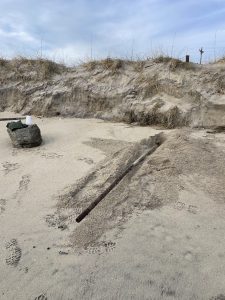
This is where things get tricky.
In the now-visible mess of deteriorated infrastructure, there is a steel pipe that’s 1-3 inches in diameter which is adjacent to the recently exposed Terminal Building.
“Based on odors coming out of the pipe and the sampling, there [may be] some type of petroleum there,” said National Parks of Eastern North Carolina Superintendent, David Hallac, in an earlier interview.
But this is likely not the only source, based on the peat sediments that routinely wash up and reek of petroleum. These stem from other sources, and likely from former marshes and sites that are further away from the oceanfront.
How often does the petroleum smell occur?
National Park Service (NPS) personnel routinely made visits to the closed shoreline, starting in September, and kept a logbook of when the petroleum smell was noticeable.
“Approximately half the times [we were there], we would smell an odor,” said Hallac in an earlier interview.
“On many occasions, we would find peat sediment, and multiple pieces of that sediment clearly smelled as if they had some sort of petroleum contamination.
“Most of these samples came back positive for petroleum contamination – and this included portions of sand, not just peat.”
It has also been noted that the smell seems to occur the most during high tides, and when sand and sediment are carved out of the adjacent dunes from substantial wave action – a process that’s informally known as vertical erosion.
Who is responsible for remediating/cleaning the beach?
The consensus by stakeholders is that there are two agencies – the U.S. Army Corps of Engineers (Corps) and the U.S. Coast Guard – who are responsible for cleaning up the site.
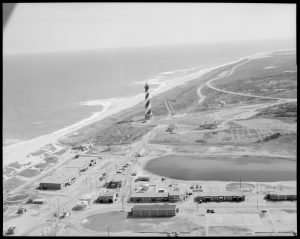
This is because of the original 1956 special use permit that said the site would be returned to its pristine condition after military activities concluded.
The two agencies are responsible for different aspects of the massive remediation efforts, however.
The persistent petroleum smells and petroleum-contaminated soils (PCS), along with the abandoned and exposed infrastructure from the former 1956-1982 Navy base, fall under the U.S. Army Corps of Engineers’ Formerly Used Defense Site (FUDS) program.
“The [FUDS] Program addresses environmental liabilities that resulted from Department of Defense activities at eligible properties,” stated Cheri Pritchard, Media Relations Chief for the Corps’ Savannah District in an email to the Island Free Presson Feb. 12. “To be eligible, the property must have been under the control of the Department of Defense prior to and transferred out of the Department of Defense control by Oct. 17, 1986.”
But a corresponding and separate issue of pesticides and PCBs, (which are manmade organic chemicals consisting of carbon, hydrogen, and chlorine atoms), is likely linked to the U.S. Coast Guard, as these problems were present at the site when the Coast Guard completely left the facilities around 2010.
Why weren’t these issues addressed before September 2023?
They were, but not completely, which is why problems have resurfaced since the September 2023 storms.
In 1998, the Army Corps of Engineers approved the Buxton Beach Access area as a FUDS site and began acting in response to petroleum contamination in several areas.
Based on reports from the Crops, seven above-ground storage tanks (ASTs) and 27 underground storage tanks (USTs), were removed from the site in the 1990s.
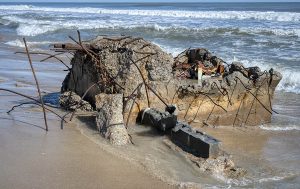
The Corps also demolished a number of structures that were not being used by the Coast Guard, including the former Driftwood Club and the Terminal Building, but evidently, not all of these structural elements were completely removed from the shoreline.
A pipeline discovered between an AST and former “Building 9” was later removed in 2000, and more than 4,000 tons of petroleum-contaminated soils (PCS) were excavated and removed from the site in 2004.
Groundwater monitoring and bioremediation by the Corps continued in the years that followed, due to detections of petroleum hydrocarbon contamination that exceeded N.C. Department of Environmental Quality standards.
Meanwhile, the Coast Guard removed a good chunk of the structures that they had used during their years of operation, including 16 buildings, a tennis court, a softball field, a swimming pool, a sewage treatment plant, two steam boilers, two diesel generators, and a TV tower.
In 2010, a report conducted by the Coast Guard found that wastewater facilities on the site had semi-volatile organic compounds (SVOC), metals, pesticides, and PCB compounds present in the surrounding soil at concentrations above EPA standards.
While the Coast Guard removed some of the wastewater facilities in 2012 that they had used, they did not remove or remediate the two drain fields that were supposed to be addressed.
“For decades, they have been performing remediation [activities],” said Hallac in an earlier interview, referring to the Corps and the Coast Guard. “It seems like more work is necessary to complete the job.”
What has been done in the last six months?
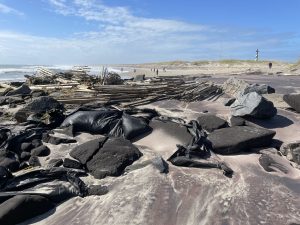
On September 1, 2023, CHNS closed a stretch of shoreline between 46285 Old Lighthouse Road and the first jetty at Old Lighthouse Beach due to the hurricane-driven exposure of old infrastructure from the former Navy base.
Also in September, Dare County and North Carolina officials issued a precautionary advisory due to impacts from petroleum-contaminated soils, which were also exposed by the recent beach erosion event.
In late October, the U.S. Army Corps of Engineers Savannah District announced that they were working with partner agencies – namely the N.C. Department of Environmental Quality – on investigative efforts to determine “any necessary corrective actions” under the umbrella of the FUDS program.
But then a roadblock occurred.
In February 2024, after a months-long investigation, the Corps stated that they could not find a direct source of petroleum, so they would be unable to conduct clean-up efforts.
“We have conducted subsurface investigations at various locations on the beach and have not found a source of petroleum,” stated Pritchard in a Feb. 12 email to the Island Free Press. “Unfortunately, in the absence of a source, the FUDS program cannot take any action at the site…
“FUDS needs to confirm there is a source associated with Navy activity at the site for this matter to fall within the scope of the FUDS program.”
In essence, although petroleum was found in the area, in the absence of a source – or a confirmed location as to where the petroleum was coming from – nothing could be done with FUDS funding, because it was not 100% certain where the petroleum originated, according to the Corps’ 2023-2024 study.
(It should be noted that during this timeframe, the Coast Guard began a CERCLA investigation at the site to evaluate the presence of non-petroleum contaminants related to their activities, which is still underway and expected to conclude during the summer of 2024.)
So, in mid-February, it looked like any remediation efforts were at a standstill, and there were no immediate solutions in sight for Buxton Beach.
Why can’t the National Park Service or Dare County clean it up?

The main reason why NPS and Dare County can’t step in is because of the scope and the massive cost of the work involved.
Removing potentially thousands of tons of petroleum-contaminated soil, (like the Corps already did in 2004), is a massive, ridiculously expensive undertaking that requires the best expertise possible.
And the Corps and the Coast Guard have resources and experience that the NPS and Dare County simply don’t have.
In addition, dissecting how petroleum infiltrated Buxton Beach tends to lead to a logical conclusion, and when it comes to the county and the National Park Service, it’s not their circus, and not their monkeys.
“It could be the U.S. Coast Guard, but we’re not aware of any fuel spills that they had in this location,” said Hallac in an earlier interview. “Could it be from a shipwreck? Sure, that’s a possibility, but would it land in this one spot out of 75 miles of [National Seashore?] Unlikely.
“Did the Navy have fuel spills here? Yes. Did the Navy have above and below-ground fuel tanks here? Yes. Did the Corps try to remove fuel here? Yes. Did the Corps’ reports say they removed all the fuel here? No.”
“There appears to be a weight of evidence that this is connected to that [Navy] site and the historic contamination.”
What are the NPS, the county, and other stakeholders doing about it?
Quite a lot. Here’s what has been happening in the past few weeks close to home.
The NPS response:
Hallac and his team have been on the frontlines of the issue since it began.
CHNS personnel routinely make visits to the closed shoreline, and report any instances of a petroleum smell – which happens roughly half the time – to the National Response Center, which is the designated federal point of contact for reporting all oil, chemical, radiological, biological, and etiological discharges into the environment.
The NPS has also been constantly and continuously working with the county as well as state and national agencies to initiate a solution as quickly as possible. They also recently launched a new webpage to keep the public informed, which has tons of details on the past, present, and future of Buxton Beach.
The Dare County response:
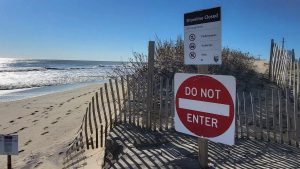
At the March 4 meeting of the Dare County Board of Commissioners (BOC), the seven-member Board passed a resolution to create a united and vocal front.
“The Dare County Board of Commissioners respectfully requests that immediate actions be taken to address the dangers posed to public health and safety—as well as the environment—to remediate the site and restore the Buxton Beach Access to its public recreational status as one of the best beaches in the United States,” the resolution reads.
“Dare County is limited in its authority to act on this,” said Hatteras Island Commissioner Danny Couch in an earlier interview, referring to the county’s involvement in entangling with the massive clean-up efforts that are required.
“But this is an approved FUDS site, with the Navy and the United States Coast Guard being there for a number of years… We’re just trying to get everyone in a room, and emerging as one.”
The county’s resolution was sent to 27 individuals, including legislators and representatives of federal agencies.
Dare County officials are also heading to Washington, D.C. later this week to meet with legislators, with the intention of putting Buxton Beach at the forefront of national attention. During the trip, the county representatives will also be attending the American Shoreline and Beach Preservation Conference, which could be another source of support.
“We – the Vice Chair [Wally Overman], myself, and the County Manager are heading to D.C., and this will be one of our top subject matters when we meet with our legislators,” said Chairman Bob Woodard at the March BOC meeting.
“This will be one of the things that is front and center when we meet in D.C.,” agreed Couch in an earlier interview. “The purpose of the resolution is to let people know that, with our hospitality economy and our reputation as the number five beach in the United States, this issue can’t be ignored.”
The public response:
Islanders who live close to the issue are also taking action to spread the word, and to encourage the public to reach out to legislators and government representatives who could potentially make a difference.
In fact, an email and letter-writing campaign was launched in mid-March to put more pressure and attention on Buxton Beach.
Additional support:
It should also be noted that on March 21, Congressman Greg Murphy, M.D. released a statement supporting local efforts to bring attention to Buxton Beach.
“I applaud ongoing efforts to address petroleum contamination along the shorelines of Buxton, NC,” said Congressman Murphy. “I am monitoring developments closely and working with local, state, and federal officials to ensure swift remediation. Thank you to Dare County, NC HHS: Public Health, Cape Hatters National Seashore, U.S. Army Corps of Engineers, and the U.S. Coast Guard for their coordination on this critical issue. I encourage surfers to please refrain from surfing in this area. I look forward to the restoration of Buxton Beach and a healthy environment along our beautiful coastline.”
What has changed in the past few weeks?
There has been some minor movement on the issue. As stated, the Coast Guard’s CERCLA investigation to address non-petroleum pollutants is underway.
In addition, the Corps is also conducting an Imminent and Substantial Endangerment (ISE) Determination analysis to possibly pave the way for remediation efforts, although it is a slow process.
The ISE Determination and subsequent Petroleum, Oil, and Lubricants Decision Document (POL DD) are new requirements of the FUDS Program (as of July 2023), and the ISE Determination is based upon the groundwater contamination of the Petroleum, Oil, and Lubricants (POL) project – a project the Corps was actively working on prior to the latest reports from the National Park Service.
“The Imminent and Substantial Endangerment Determination gives the U.S. Army Corps of Engineers’ FUDS program the ability to move on to the next step, which is the Petroleum, Oil, and Lubricants Decision Document (POL DD),” stated Pritchard in an email to the Island Free Press on March 7. “The POL DD will detail the proposed remedial action, if warranted…
“We are actively working on completing it, and it is a priority.”
Per a March 27 update from Pritchard, however, it’s not clear whether the ISE Determination will result in remediation action down the road.
“The ISE determination is not based on the current site conditions reported [by] the National Park Service,” stated Pritchard. “Current (groundwater) sampling will continue at the site until the POL DD is signed, (likely late in the 3rd quarter or early in the 4th quarter), and it will determine the path forward for that site.”

Meanwhile, Dare County officials are actively working on corresponding initiatives to ensure that the health hazards of Buxton Beach stay on the public’s radar well into the summer months, as new and potentially unaware visitors land on the Outer Banks.
“We’re putting together a video that will come together as a collaboration between the county and our partners to increase awareness and provide information as to what [the public] can do, and [how] to report issues,” said Sheila Davies, Director of Health and Human Services for Dare County, in an earlier interview.
“The big thing is to let people know what the health risks are, and what to do in case of exposure [in terms of] cleaning and taking care of themselves,” said Davies. “If you’re going to that beach, at least you know the risks associated with what you’re doing, and what to do next.
“It’s way past time for the remedy to occur… But for now, our focus has to be what [the problem] is, how to protect yourself, and how to report an exposure.”
Can the public visit Buxton, and the Cape Hatteras National Seashore in general?
Absolutely, yes. Keep in mind that just three-tenths of a mile of the shoreline is closed, out of 75 miles of National Seashore.
So, if it’s just a small area of shoreline that’s closed, what’s the big deal?
The concerns are two-fold.

Arguably, the number one worry is that the problem will spread.
The petroleum smells didn’t become persistent until those two September 2023 storms accelerated the erosion in the immediate area.
And the expansion of the Buxton Beach closure didn’t occur until March 24, 2024, after a low pressure system altered the shoreline once again. If more hurricanes or storms hit, the issues could potentially grow and expand even more.
After all, it’s unclear what the precise contaminants are, (there could be many), where they are located, and how large the problem is.
This uncertainty, and the many issues reported so far, constitutes a public health and environmental emergency. And the problem is progressively getting worse.
The second concern is that as the busy summertime season starts, visitors will be affected. The closure is next to the Old Lighthouse Beach, which is consistently ranked as one of the best beaches in the United States by Dr. Steven Leatherman, who is better known as “Dr. Beach.”
Contact with petroleum can cause headaches and other, more serious health issues. When local surfer Brett Barley encountered the now-infamous fuel sheen during a February surfing session at Old Lighthouse Beach, he said that he reeked of petroleum long after he got out of the water.
“It became very apparent how much more severe this situation was than previously thought back in the fall, and [from] what you can observe from the land,” said Barley in an earlier interview.
“I came home, and my wife could smell the diesel on me, even after scrubbing my face with soap and showering.”
What can the public do to help get the ball moving?
A good starting point is to join the email and letter-writing campaign, which was recently launched by Buxton community members.
Also, visitors who encounter a petroleum smell or fuel sheens while visiting the Buxton shoreline near Old Lighthouse Road should call the National Response Center at 1-800-424-8802 to report the encounter. Include the date, time, location, and basic details of what was seen or smelled, and do not call if you have not experienced the issue first-hand, or have not been physically affected. The National Response Center is solely for reporting real-time information on petroleum smells or sheens in the Buxton area, as they happen.
Anything else I should know?
Yes. Every person the Island Free Press has interviewed so far who has been affected by the situation believes the end-game goal is not pointing fingers, but fostering cooperation.
“Everyone can work together to try and get some things moving here,” said Couch in an earlier interview.
“There are no bad guys here…Communication has been open and transparent and cooperative. [There is] nothing to suggest any kind of cover-up. There’s just a job to do, and all of the ingredients are there to come up with a solution.”
Editor’s Note: Two hours after this story was originally published, the Dare County Health Department issued a revised Precautionary Public Health Advisory for Buxton Beach, which is the second advisory released to the public since September 2023.



